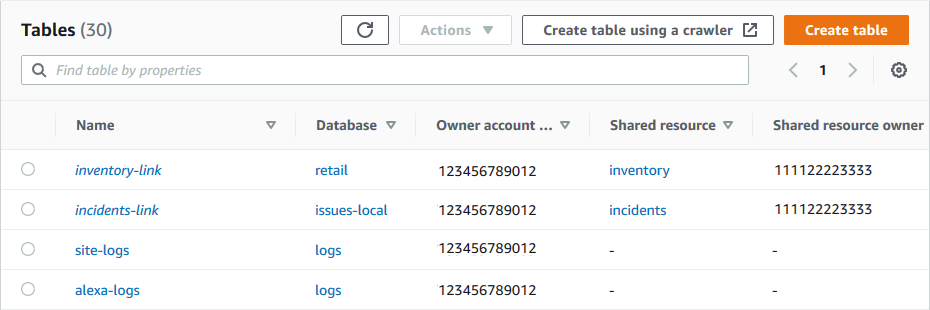How resource links work in Lake Formation
A resource link is a Data Catalog object that is a link to a local or
shared database or table. After you create a resource link to a database or table, you can use
the resource link name wherever you would use the database or table name. Along with tables
that you own or tables that are shared with you, table resource links are returned by
glue:GetTables() and appear as entries on the Tables page
of the Lake Formation console. Resource links to databases act in a similar manner.
Creating a resource link to a database or table enables you to do the following:
-
Assign a different name to a database or table in your Data Catalog. This is especially useful if different Amazon accounts share databases or tables with the same name, or if multiple databases in your account have tables with the same name.
-
Access the Data Catalog databases and tables from any Amazon Region by creating resource links in those regions pointing to the database and tables in another region. You can run queries in any region with these resource links using Athena, Amazon EMR and run Amazon Glue ETL Spark jobs, without copying source data nor the metadata in Glue Data Catalog.
-
Use integrated Amazon services such as Amazon Athena and Amazon Redshift Spectrum to run queries that access shared databases or tables. Some integrated services can't directly access databases or tables across accounts. However, they can access resource links in your account to databases and tables in other accounts.
Note
You don't need to create a resource link to reference a shared database or table in Amazon Glue extract, transform, and load (ETL) scripts. However, to avoid ambiguity when multiple Amazon accounts share a database or table with the same name, you can either create and use a resource link or specify the catalog ID when invoking ETL operations.
The following example shows the Lake Formation console Tables page, which lists
two resource links. Resource link names are always displayed in italics. Each resource link is
displayed along with the name and owner of its linked shared resource. In this example, a data
lake administrator in Amazon account 1111-2222-3333 shared the inventory
and incidents tables with account 1234-5678-9012. A user in that account
then created resource links to those shared tables.

The following are notes and restrictions on resource links:
-
Resource links are required to enable integrated services such as Athena and Redshift Spectrum to query the underlying data of shared tables. Queries in these integrated services are constructed against the resource link names.
-
Assuming that the setting Use only IAM access control for new tables in this database is turned off for the containing database, only the principal who created a resource link can view and access it. To enable other principals in your account to access a resource link, grant the
DESCRIBEpermission on it. To enable others to drop a resource link, grant theDROPpermission on it. Data lake administrators can access all resource links in the account. To drop a resource link created by another principal, the data lake administrator must first grant themselves theDROPpermission on the resource link. For more information, see Lake Formation permissions reference.Important
Granting permissions on a resource link doesn't grant permissions on the target (linked) database or table. You must grant permissions on the target separately.
-
To create a resource link, you need the Lake Formation
CREATE_TABLEorCREATE_DATABASEpermission, as well as theglue:CreateTableorglue:CreateDatabaseAmazon Identity and Access Management (IAM) permission. -
You can create resource links to local (owned) Data Catalog resources, as well as to resources shared with your Amazon account.
-
When you create a resource link, no check is performed to see if the target shared resource exists or whether you have cross-account permissions on the resource. This enables you to create the resource link and shared resource in any order.
-
If you delete a resource link, the linked shared resource is not dropped. If you drop a shared resource, resource links to that resource are not deleted.
-
It's possible to create resource link chains. However, there is no value in doing so, because the APIs follow only the first resource link.